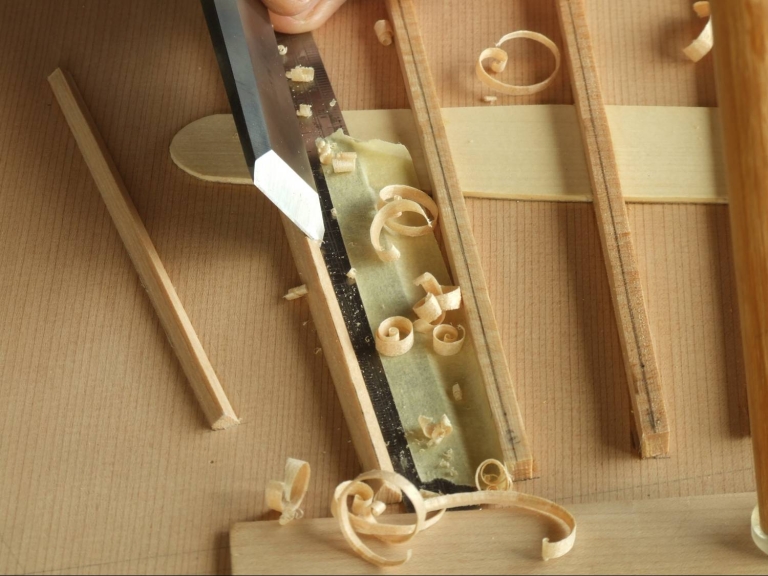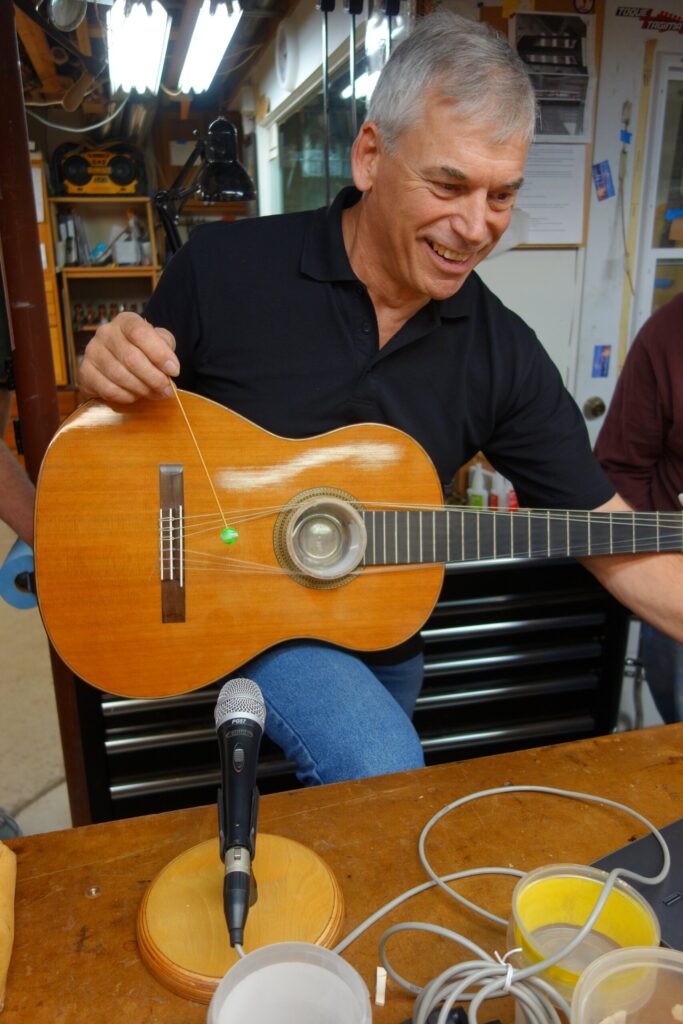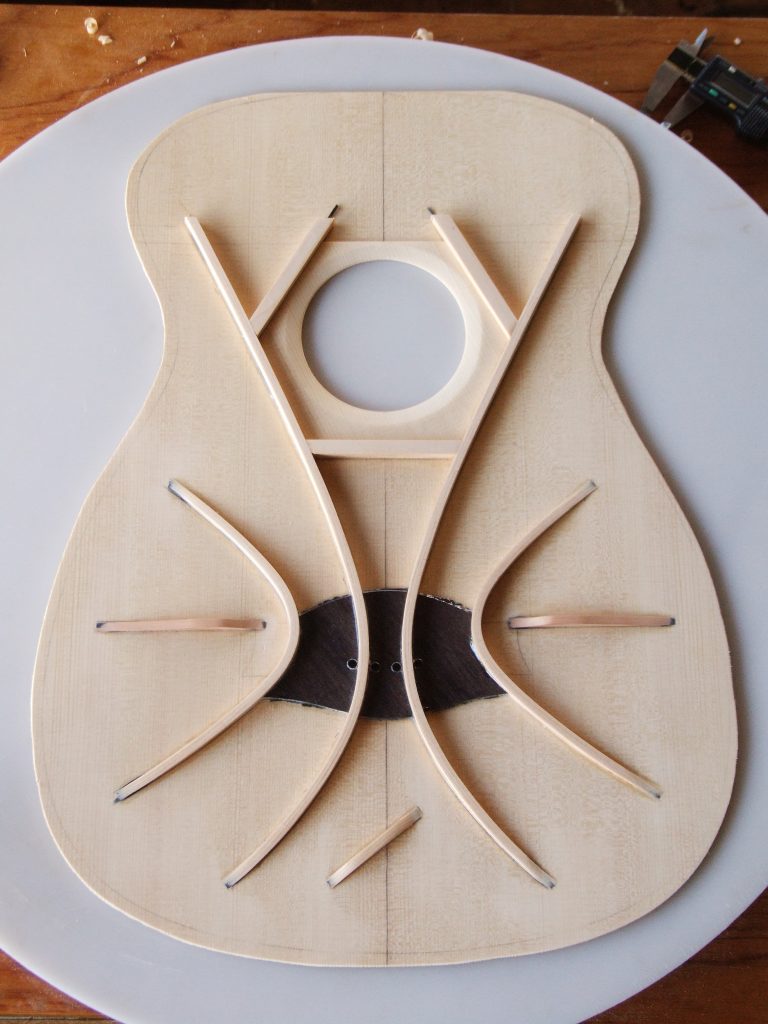3-day Modal Tuning Course
I have been running this course since 2009, a couple of years before the book was first published, though the book was pretty much finished at that time. In the years since, I have run the course around 30 times in Australia, USA and Europe, with around 350 guitar makers, big names and small, having greatly enjoyed and benefited from the course. The course brings to life the first volume of the book, “Design”, and covers in detail the mathematical elements that non-mathematicians find challenging.

Introduction to Modal Tuning
Trevor Gore
The course is based round the following concepts:
- Guitars radiate sound from their vibrating parts, mainly the top plate
- If a guitar top vibrates in a different way, it produces a different sound
- The different ways a guitar top vibrates are called modes
- If the modes are tuned to resonate at particular frequencies with particular amplitudes, we can shape the way a guitar sounds
- In the workshop we explore the theory and practice of mode tuning to help you achieve the sound you want from your guitar
- The course outline and more detailed course content can be downloaded by clicking on the hyperlinks.
I run the course when demand is sufficient. Typically 10 participants are required. Usually, a lead participant takes on the organising role for that location, which can be almost anywhere, and the lead participant benefits by having a low cost participation fee. The cost for participants varies considerably based on location, venue hire, travel and accommodation costs, etc., but if you are interested, contact me via the Contact page and let me know where you are. Two courses back-to-back dilutes the costs significantly.
Guitar Analysis and Testing

I’ve run the Modal Tuning Course at Robbie O’Brien’s place in Parker, Colorado eleven times as of 2024. People have frequently requested that I do a video of the course having heard about it but not being able to attend. This is NOT that video course! However, Robbie is a great guy and persuaded me to video the tests that I demonstrate in the Modal Tuning Course and that I use when I am designing and building guitars, so people can now see how the tests are set up and done, rather than just reading about them.
This video-based course will help you avoid technical setbacks and shorten your learning curve when setting up the hardware and software needed to capture frequency response curves. It shows you how to measure the monopole mobility (responsiveness) and other critical performance indicators of your guitar. You can learn how to do all of the major tests that I do while building my guitars.
The video course is not meant to substitute the information contained in the books, but rather facilitate the understanding, setup and execution of the tests described in the books.
Learn about:
- How to set up microphones for testing
- How to install and structure Visual Analyzer software on your computer.
- How I made my custom signal generator
- Tap testing for frequency response curves
- Using Chladni patterns to verify modes of vibration
- Measuring material properties
- How to determine soundboard thickness
- How to measure monopole mobility
- How to measure bridge rotation under string loads
The introduction to the course can be viewed for free below.
The rest of the course is being kindly hosted by Robbie O’Brien and can be accessed via the Lutherie Academy website.
Falcate Bracing with Trevor Gore
The ever-enthusiastic Robbie O’Brien invited me to film this video series when I visited him in July 2022, motivated by all the enquiries he was receiving for such a course.
I invented the falcate bracing system for steel string and classical guitars back in 2005, and first published the build methodology in “Contemporary Acoustic Guitar Design and Build” in 2011. Many luthiers around the world are now using this system to improve the tonal properties of their instruments and make them more responsive. Previously, you had to study the books to understand how to use this bracing system. Now, in this series of videos, you can see me explain every step of the process in great detail from designing the bracing layout to attaching the top and back to the sides of the instrument and measuring the resonant frequencies of the box; the fully coupled air, top and back resonances.

In this video series you learn about:
- How the falcate bracing system came about
- Milling, bending and laminating the falcate braces
- How to determine top and back thicknesses
- Brace layout and bridge patch positioning
- Types of carbon fibre and which one to use
- Types of epoxy used in falcate bracing
- Sound hole reinforcement
- Gluing braces to the soundboard
- Shaping the braces
- Live and non-live backs and how to achieve them.
- Tuning the back
- Capturing the resonant frequencies
The introduction to the course can be viewed for free below.
The rest of the course is being kindly hosted by Robbie O’Brien and can be accessed via the Lutherie Academy website.
Feedback:
“This is a great course. Not only does Trevor show in all details how to make, apply and shape the falcate braces, but you get a lot of other info along the way, like thicknessing the top and back with the help of measuring the long grain, cross grain and “twist” Young’s modulus as well as the density of the wood. It’s apparent that Trevor has done this plenty of times – and there is no better source for this out there as he is the original inventor and master of falcate bracing! Highly recommended – and thanks to Robbie for making it available!” Florian in Austria
See what others are saying at the Lutherie Academy
Podcasts
Talking Acoustics
Matthew Ottley is a professional acoustician. He has produced a series of podcasts in which he interviews people in the world of acoustics who have piqued his interest. Matthew looked me up in March 2018, and recorded around 75 minutes of an in depth discussion about the design and function of guitars. If you’d like to listen, here it is: Trevor Gore interviewed by Matthew Ottley for Talking Acoustics.
Luthier on Luthier
Amongst the cognoscenti I was fortunate enough to meet when I was in Parker, Colorado in 2019 was the very eminent Michael Bashkin. He asked if he could interview me for his Luthier on Luthier series of podcasts that he has conducted in conjunction with the Fretboard Journal. I was pleased to oblige. We had about an hour of wide ranging discussion about my journey from engineer and boat builder to guitar maker and author. Not the usual way into guitar building! You can download the podcast from here.